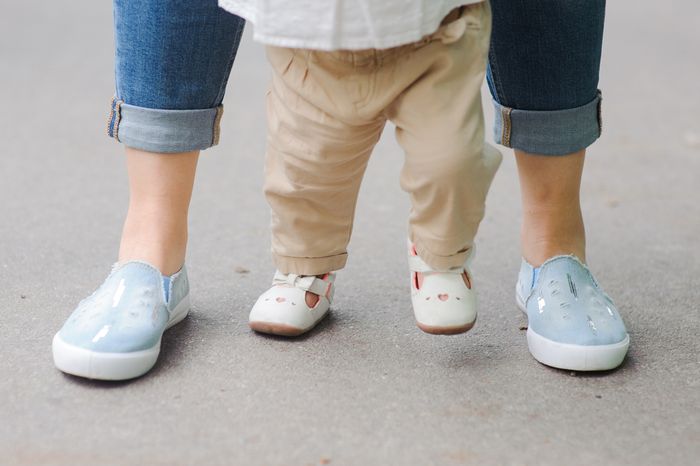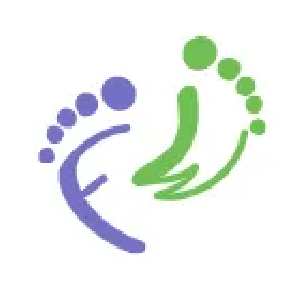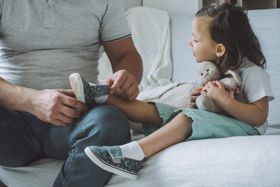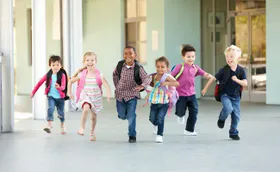Bowlegged to Straight: Understanding Your Baby's Leg Development
Updated August 14, 2023.

Have you ever noticed your baby's legs curving outward at the knees and wondered if it's normal? Rest assured, you're not alone. We'll explore the developmental stages of a baby's lower extremities and provide practical advice on how you can support their growth.
What Are Bowlegs?
Bowlegs, a condition medically known as genu varum, is characterized by a child’s legs curving outward at the knees. When the child stands upright with the feet facing forward, the knees curve outward while the ankles and feet meet, creating a distinct “bow” shape. This condition is relatively common in infants and toddlers and is usually considered a normal part of their growth and development.
But why are newborn legs bowed? The primary reason is their position in the womb, which causes their legs to be flexed. As your child begins to put weight on their legs and learns to walk, this physiological bowleg usually straightens. This process typically starts around the time a child takes their first step, usually around 12 months, and is generally resolved by the time they're about two years old, and children even experience knock knees between the ages 3 and 5.
Did you know?
Walking barefoot can help improve balance and coordination in babies. It allows them to grip the floor and helps them develop the muscles and ligaments of the foot.
Stages of Leg Development
Understanding the developmental stages of your child's lower limbs can help you better support their growth. Here's what you can expect:
0-2 Months
At this stage, babies’ limb movements are primarily influenced by innate reflexes typical of newborns. For example, if you hold your newborn on your lap while supporting their head, you can feel their feet pushing against you gently. Around six weeks, these newborn reflexes begin to diminish, and the baby’s strength and coordination improve.
3-6 Months
Your baby may start to put weight through their legs. By six months, they will have the strength to bounce while you’re holding them in a standing position. They may also practice "walking" when their feet touch the floor. These are all preparations for the next significant milestones: crawling and standing.
6-10 Months
Babies start gaining more muscle control between 6 and 9 months. They develop leg and trunk coordination and start to crawl using both their hands and feet. Some babies will start to pull on furniture to stand. But the timing and sequence of these milestones vary widely.
Endeavour to clear the space around your baby from toys and sharp objects when he’s trying to stand, and lay a few cushions on the floor in case your baby falls. Remember that when your baby pulls up on the furniture, they may stand on their toes first, and that's perfectly natural.
10 Months - 1 Year
Around 1 year old, your baby might be able to stand independently and take a few steps without support. This is a great time to encourage your toddler to develop their gross motor skills by providing safe, flat surfaces for them to explore.
» Check out our list of best shoes for tippy-toe walkers
Practical Ways to Support Your Baby’s Leg Development
You can support your child’s leg development by allowing them to stretch and move their leg muscles freely; it enhances healthy walking patterns later. The stronger your baby’s leg muscles get, the sooner they will stand. If your newborn’s leg muscles are a little stiff compared to the upper limbs, there’s nothing to worry about. They are in the early stages of development, and the leg development starts a little later than the upper limbs.
Here are some practical ways to support your baby’s leg development and the correction of bowlegs:
- Playtime: Engaging your infant in various movements during playtime helps strengthen leg muscles. Activities such as kicking, crawling, rolling, and reaching for toys promote muscle development and enhance the strength and coordination of their legs.
- Gentle exercises: Age-appropriate physical exercise is essential for promoting overall motor development in babies. If your baby has stiffness in their legs, you can gently massage and cycle their legs.
- Frequent tummy times: Placing your baby on their tummy during playtime helps develop neck, back, and shoulder muscles, supporting the development of strong core muscles. A strong core is essential for maintaining proper posture and balance, which can positively impact leg development.
- Supportive Shoes: Supportive pre-walker shoes for infants often have features such as arch support, cushioning, and ankle stability. These features can help promote proper alignment of the feet, ankles, and legs, which is important for healthy leg development.
Parenting Tip: Encourage your baby to move by placing toys just out of their reach during tummy time. This can help strengthen their leg muscles as they try to reach for the toys.
» Here's our selection of shoes for learning to walk
Embrace the Journey
Remember, bowlegs are a normal part of infancy. If you notice that the bowing of your child’s legs continues to worsen after age 2 or your child experiences pain, it's important to consult with a physician for an expert assessment.
In the meantime, you can actively support your baby's leg development. One way to do this is by investing in supportive pre-walker shoes. For example, First Walkers’ shoes for pre-walkers offer support and protection for your infant’s feet while they explore their environment. These shoes can help shield their feet from sharp objects, rough surfaces, or temperature variations, allowing them to move around more comfortably and safely.
However, it's important to remember that pre-walker shoes are not meant to replace barefoot time. Allowing your child time to explore their environment barefoot is crucial for natural foot development.




